
Cricklepit Mill
Page updated 25 August 2009
See the videos Cricklepit
Mills opens 2008.
Cricklepit
Mill working
The most well known of Exeter's mills is Cricklepit, which is also the only one to survive into the 21st Century. As already mentioned, Robert Courtenay granted Nicholas Gervaise the right to build his mill at Crickenpette in 1180/90.
Records show that in 1463, Crickenpette was still working steadily as a grist mill or corn mill. In 1529 the mill was remodelled and part of the present structure dates from this time, still as a corn mill. The historian, Jenkins wrote of the famous Matthew the Miller, who is said to have lived his life precisely to the tick of the St Mary Steps clock, thus helping the locals know the time, "This Matthew was an opulent Miller, who resided at Cricklepit; he was remarkable for his integrity".
In 1689, one of Cricklepit's wheels used a treble mill gearing system to drive two millstones, one of which was grinding malt by 1689. By the 18th Century, Cricklepit Mill was also fulling wool, grinding malt and producing flour. The mill complex, had three wheels in 1757, driving three grist and two fulling mills. A single wheel could drive two fulling stocks directly off the mill shaft, through a simple trip cam mechanism. The actual building containing the fulling stocks was often quite small and cramped.
Cricklepit was often put to new uses, so long as it was power that was required, and the water wheels drove a rubble machine, and a manganese mill in the 19th Century, alongside its other duties. The Napoleonic Wars had put paid to Exeter's woollen exports, and consequently the processing of wool quickly died out. Exeter's remoteness from the coal fields meant that the water wheels were still needed to provide power for a variety of industries.
There is a Joseph Gattey recorded in 1800 as a flour merchant of the city; it is not known if he worked Cricklpit Mill, although a John Gattey was a miller at Cricklepit in 1809. Mr William Mann was the miller in 1824, when his 7 year old son was knocked down in Old Bridge Street, by a cart, which did not stop - an early hit and run. The boy was taken to the surgeon where he was found to have suffered severe bruising around the head, and was in danger for a time.
Richard Kelland
Richard Kelland was recorded in the 1841 census as a miller in Cricklepit Lane, and as the miller, in the Flying Post, at Cricklepit in 1854. In 1857, he was a signatory to the newly formed Millers and Corn Merchants Sack Protection Society. He was accused of adultering his flour with alum in a court case in 1858, along with other millers, a charge which was not proven.
In the 1861 census, he was employing one man and one boy. By 1866, the mill was in the occupation of Mr Frederick Pitts, and was for let. Mr Pitts was suffering from ill health, necessitating the sale. It was capable of eighty to ninety sacks per week, indicating that it was one of the smaller mills in the city; Powhay Mills in 1877 could produce 500 sacks.
In Exeter, the industrial revolution saw the emergence of many iron foundries, often using machinery driven by water. In 1868, Cricklepit took delivery of a new wheel, cast nearby by William Bolt at the Old Quay Foundry.
A fire in January 1878, on woodwork surrounding the millstones was put out, before the brigade arrived, by the foreman and neighbours dipping buckets in the leat. The owner was Woodbridge and Sons who also ran the Lower Mill, a few metres further down the leat.
In 1907, Cricklepit was also a saw mill; at this time, perhaps a half of Shilhay was devoted to storing and sawing timber, and there would have been a requirement, from time to time for extra capacity, which Cricklepit could fulfil. And all the time, Cricklepit was still grinding corn for animal feed and flour.
In 1914, the mill was occupied by William French & Co, corn dealers who purchased the property in 1920. In 1953 French's sold the mill to Henry Eke and Walter Percy Keeling. By 1970 the buildings were no longer a working mill and were used by Shears for storing animal feed.
Cricklepit has been the subject of much speculation during the last few years - abandoned and deteriorating, it suffered a fire in 1999. It was decided to save what remained of Exeter's last water mill, and the site was sold to the Devon Wildlife Trust, with help from Exeter City Council, Exeter Canal and Quay Trust and English Heritage. Traditional millwright Martin Watts was contracted to renovate the mill. On completion, the mill became the headquarters of the Trust, and is now used as offices and a wildlife information centre that is open to the public.
Sources are listed in the mills menu page
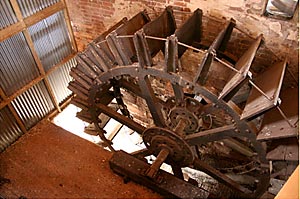 The water wheel inside Cricklepit Mill.
The water wheel inside Cricklepit Mill.
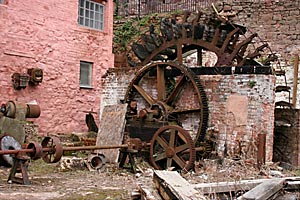 The water wheel outside Cricklepit
Mill. The mill building is on the
left, the City Wall behind.
The water wheel outside Cricklepit
Mill. The mill building is on the
left, the City Wall behind.
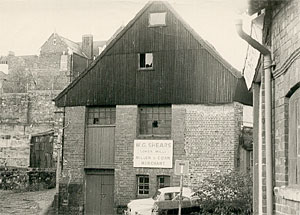 The front of Cricklepit when it was owned by Shears in the 1950's. Photo courtesy of Alan Mazonowicz.
The front of Cricklepit when it was owned by Shears in the 1950's. Photo courtesy of Alan Mazonowicz.
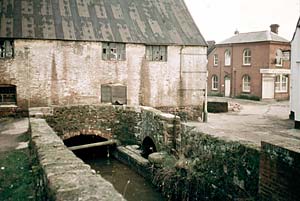 The leat that flows through Cricklepit Mill splits into three - left and straight on to power wheels and a small overflow to the right.
Photo taken in the early 1970's, courtesy of Alan Mazonowicz.
The leat that flows through Cricklepit Mill splits into three - left and straight on to power wheels and a small overflow to the right.
Photo taken in the early 1970's, courtesy of Alan Mazonowicz.
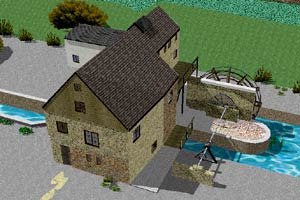 A 3D rendered illustration of Cricklepit Mill from the south. Created
by David Cornforth
A 3D rendered illustration of Cricklepit Mill from the south. Created
by David Cornforth
│ Top of Page │